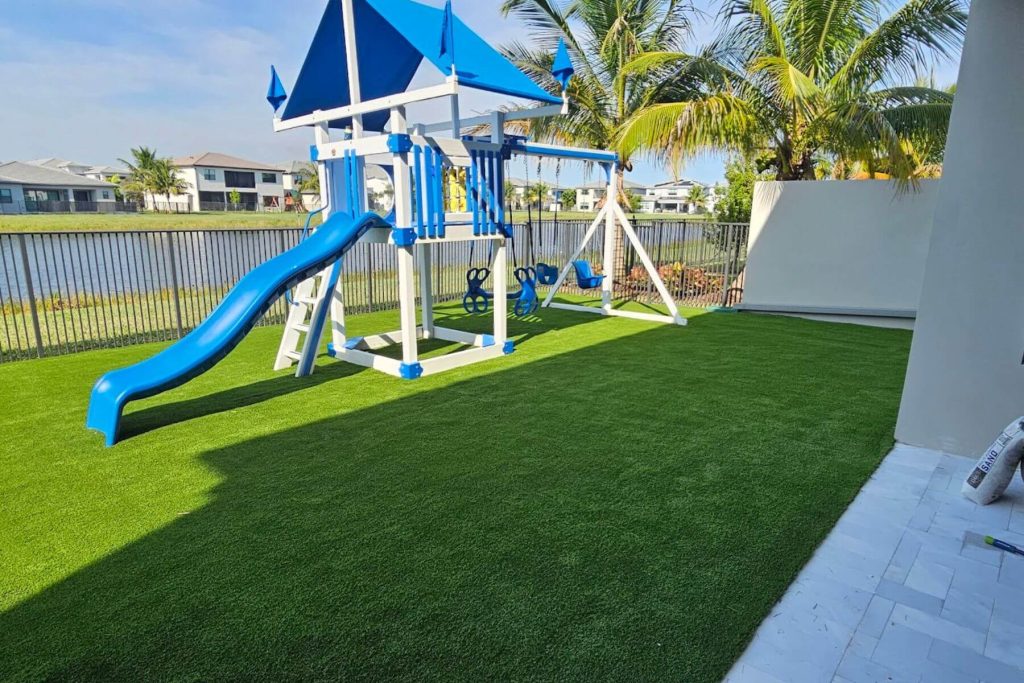
Artificial grass has become a popular choice for homeowners and businesses alike, offering a lush, green appearance without the hassle of traditional lawn maintenance. But is artificial grass toxic or safe? As its popularity grows, so do concerns about its safety. Are there hidden risks associated with artificial grass, or is it a safe alternative to natural lawns?
In this article, we’ll explore the question: Is artificial grass toxic? We’ll dive into the materials used, potential risks, and expert opinions to help you make an informed decision.
Understanding Artificial Grass
Manufacturers create artificial grass, also known as synthetic turf, from various materials to mimic the look and feel of natural grass. The primary components include:
- Polyethylene (PE): A common plastic used for the grass blades, providing a soft texture.
- Polypropylene (PP): Another type of plastic used in some turf, known for its durability.
- Nylon: Used in higher-end products for its strength and resilience.
The backing of artificial grass typically consists of a combination of latex or polyurethane, which secures the blades and provides stability. Infill materials like crumb rubber or sand help the grass maintain its shape and provide cushioning.
Is Artificial Grass Toxic?
1. Chemical Concerns
One of the main concerns about artificial grass is the presence of chemicals in the materials used. For example, some artificial grasses are made with crumb rubber infill, which is produced from recycled tires.
Crumb rubber contains chemicals like lead, cadmium, and other heavy metals. When heated by the sun, these chemicals can potentially leach out, raising concerns about their impact on human health and the environment.
2. Volatile Organic Compounds (VOCs)
Another potential issue is the emission of volatile organic compounds (VOCs) from synthetic turf materials. VOCs are chemicals that can evaporate into the air and may cause health problems if inhaled in high concentrations.
Some studies have suggested that synthetic turf can release VOCs, particularly in hot weather. However, the levels of VOCs emitted are typically low and considered within safe limits by regulatory agencies.
3. Microplastics and Environmental Impact
Artificial grass contributes to the problem of microplastics in the environment. Over time, the plastic fibers in synthetic turf can break down into tiny particles that can be washed away into the soil and waterways.
These microplastics can pose a threat to wildlife and ecosystems. While the environmental impact of artificial grass is less than that of some other plastic products, it’s still an important consideration.
Expert Opinions and Safety Measures
1. Regulatory Standards
Many countries have regulations in place to ensure the safety of artificial grass products. For example, in the United States, the Environmental Protection Agency (EPA) and the Consumer Product Safety Commission (CPSC) monitor and set standards for the materials used in synthetic turf.
Products that meet these standards are generally considered safe for use in residential and commercial settings.
2. Mitigating Risks
To minimize potential risks associated with artificial grass, it’s important to:
- Choose Products Wisely: Look for artificial grass made with low-VOC materials and free from harmful chemicals. Reputable manufacturers will provide information about their products’ safety and environmental impact.
- Proper Installation: Ensure that the turf is installed correctly, with proper drainage and ventilation, to reduce the risk of chemical buildup and overheating.
- Regular Maintenance: Regular cleaning and maintenance of artificial grass can help reduce the accumulation of dust, debris, and microplastics.
Implications for Homeowners and Businesses
Choosing artificial grass involves weighing the benefits against potential risks. While artificial turf offers a low-maintenance, aesthetically pleasing option, it’s important to consider its environmental impact and potential health concerns.
For homeowners and businesses, this means making informed choices about the materials and products used, as well as implementing measures to mitigate risks.
Insights and Perspectives
Some argue that the benefits of artificial grass outweigh the potential risks, particularly in areas where maintaining a natural lawn is challenging due to water restrictions or harsh climates. Others believe that the long-term environmental and health impacts of synthetic turf warrant a closer examination and consideration of alternative options.
The question of is artificial grass toxic is complex and multifaceted. While there are valid concerns about the chemicals and microplastics associated with synthetic turf, many products meet safety standards and offer a practical solution for maintaining green spaces.
Curious about whether artificial grass toxic or safe choice for your property? Contact Ben Turf Landscaping to learn more about your options and make an informed decision about your lawn.

